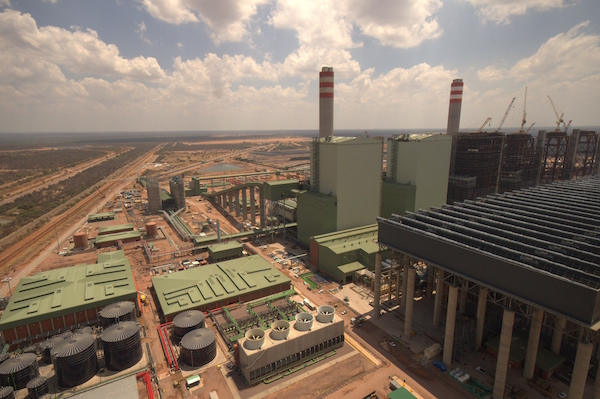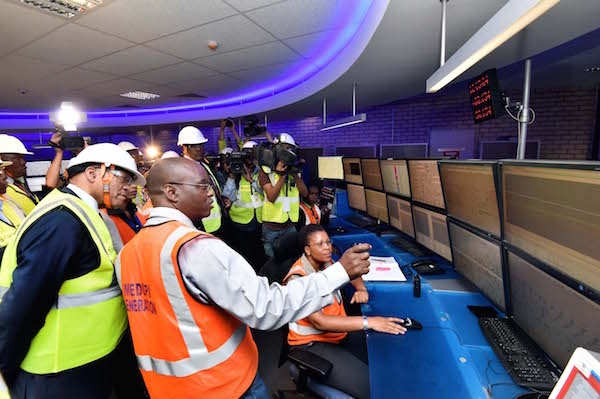

The first of the 4,764-MW Medupi coal-fired powerplant's six units commenced commercial operations in South Africa in September, almost six months after it was synchronized to the national grid and three years after it initially was set to be operational.
The entire $7.6-billion project, developed by South Africa’s state power company Eskom, has an operational life of 50 years and is slated for completion in 2019. However, intermittent labor unrest and technical challenges have delayed completion of various work on unit No. 6, the deadline of which could be revised to accommodate the disruptions.
The unit at the greenfield dry-cooled coal plant, 15 kilometers west of Lephalale in the Limpopo, was commissioned officially in late August to feed the national grid 794 MW; it is a major boost to Eskom, which has been battling frequent load shedding as energy shortages bite and are said to have reduced the country’s economic growth by 2% last year. The unit increases Eskom’s total installed capacity to 45,000 MW.
“The commercial operation of unit No. 6 is a critical milestone in our effort to build new generating capacity to meet South Africa’s rising electricity demand,” said Eskom’s CEO Brian Molefe in late August.
Completion of unit No. 6 was preceded by delays that included pushing to March 2014 from December 2013 its synchronization to the national grid. That delay was linked to labor disputes between workers and Eskom’s contracted companies and what the power generator said was “extensive work on realignment as a result of fraudulent activities by contractors, insufficient construction labor on-site and poor productivity.”
For the past two years, members of the National Union of Metalworkers of South Africa have been disrupting construction works at Medupi, the first base-load powerplant in South Africa in 20 years. Workers and contractors engaged in disputes over commuting, traveling and taxation allowances, stoppage of pay during unprotected strikes and payment of bonuses. Medupi project contractors this year fired more than 1,000 workers accused of engaging in unprotected strikes that led to the construction shutdown. At least 4,000 workers were engaged in a major strike between March and June, but some were allowed back after appearing before the disciplinary committees of various employers.
The delays also have stemmed from a few subcontractors seeking compensation from Eskom after their project completion deadlines were stretched beyond earlier, agreed-uon deadlines.
French firm Alstom was the supplier and installer of the steam turbines, turbo-generators, air-cooled condensers, turbine island auxiliary equipment and associated erection services for the six Medupi units under a $942-million contract, awarded in 2007. Paul O’ Flaherty, former Eskom director, in a media interview early last year said both Alstom and Japanese equipment supplier Hitachi were to blame for the delay in Medupi project progress, a situation that was exacerbated by frequent workers’ strikes. However, Alstom told Bloomberg last year: “The boiler-protection system is a complex system, and, in the case of Medupi, the configuration requested by Eskom is demanding and unusually complex compared to industry standards.”
Hitachi led a consortium comprising Hitachi Power Europe and Hitachi Power Africa in winning a $1.4-billion boiler contract, also awarded in 2007.
Eskom also has signed a 40-year contract with South Africa heavy-minerals firm Exxaro Resources for the supply of 14.6 million metric tons of coal from its Grootegeluk coal mine.
Government records show that South Africa, which relies on coal for up to 90% of its electricity, last year produced 252,578 GWh, a 1.4% decline compared with 256,073 GWh in 2013. Power consumers used 231,445 GWh of electricity, a 0.7% decline from 2013’s 233,105 GWh.
South Africa’s electricity imports last year also increased by 18.6%, to 11,177 GWh from 9,428 GWh in 2013. However, Robert Molefe, who was confirmed by the South African cabinet as Eskom’s CEO on Sept. 25, said Eskom, which supplies 95% of South Africa’s electricity, hopes over the next five years to increase its generation capacity by 17,384 MW, transmission lines by 9,756 km and substation capacity by 42,470 MW.
“This will enable us to provide security of electricity supply to South African homes and businesses, powering economic expansion and extending electricity to millions of households [that] have previously relied on other fuel sources for domestic cooking and heating,” Molefe said.
The African Development Bank has provided $500 million for Medupi, while the World Bank had committed $3.05 billion, despite criticism it was violating its own policy by supporting a project that threatens to worsen global greenhouse-gas emissions.


Post a comment to this article
Report Abusive Comment